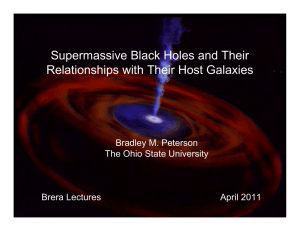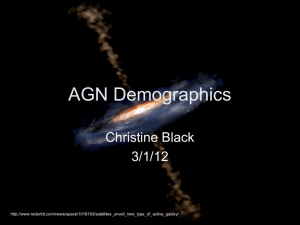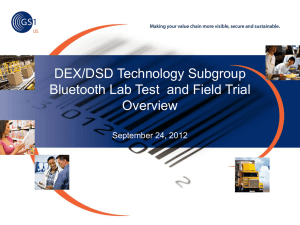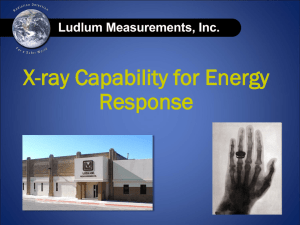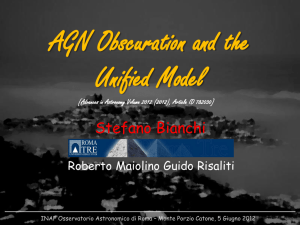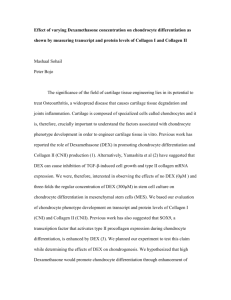A New Cosmological Distance Measure Using AGN X
advertisement
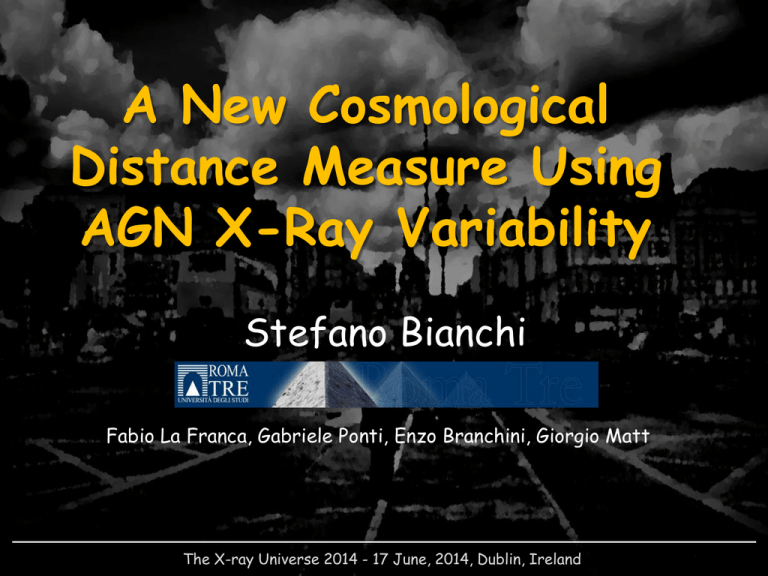
A New Cosmological Distance Measure Using AGN X-Ray Variability Stefano Bianchi Fabio La Franca, Gabriele Ponti, Enzo Branchini, Giorgio Matt The X-ray Universe 2014 - 17 June, 2014, Dublin, Ireland One of the most important results of observational cosmology is the discovery of the accelerating expansion of the universe, using SNeIa as standard candles However, the use of SNeIa is difficult beyond z ∼ 1 and limited up to z ∼ 2 Given their high luminosities, there have been several studies on the use of AGN as standard candles Virial BH Masses: From Reverberation Mapping to Single-Epoch Methods The BLR in AGN is powered by photoionization from the central source. RM lags provide an estimate of its size. If we assume that the BLR is virialized and dominated by the gravitational field of the central BH, then the BH mass is Geometrical Factor BLR Velocity (FWHM) BLR Radius (RM lag) Bentz et al. 2009 RM observations found a tight correlation between the BLR size and the optical continuum luminosity. A slope of alpha = 0.5 is found, as expected, if U and the electron density are more or less constant, and/or if the BLR size is set by dust sublimation It was suggested to use the R - L relation (~0.15 dex) as an absolute luminosity indicator, although RM is very time consuming and still limited to local AGN Virial BH Masses: From Reverberation Mapping to Single-Epoch Methods The observed R-L relation provides a much less expensive way to estimate the size of the BLR, allowing a single-epoch virial BH mass estimator: from the same spectrum, one estimates the BLR size from the measured luminosity using the R-L relation, and the width of the broad emission line (typically, Hβ or MgII 2798Å or CIV 1459Å). The derived BH masses have uncertainties ~0.5 dex Shen & Liu 2012 BH Mass and X-ray Variability AGN X-ray PSDs are generally well modeled by two power laws, P(ν) ∝ 1/νn, where the PSD slope is n∼1 down to a break frequency, νb, that scales primarily with MBH, and then steepens to n∼2 at larger frequencies McHardy et al. 2006 106 M AGN Uttley et al. 2005 GBHs 108 M 107 M The break frequency scale with MBH in all accreting BHs BH Mass and X-ray Variability Kelly et al. 2013 AGN X-ray PSDs are data demanding, requiring high-quality data on different timescales. On the contrary, the excess variance is a robust estimator as it corresponds to the integral of the PSD on the timescales probed by the data The scaling of the characteristic frequencies of the PSD with MBH induces a dependence of the excess variance with MBH (if computed at frequencies above νb) BH Mass and X-ray Variability Several studies have indeed found a significant anti-correlation between MBH and X-ray variability (Nandra et al. 1997; Turner et al. 1999; Lu & Yu 2001; O’Neill et al. 2005; McHardy et al. 2006; Gierliński et al. 2008; Zhou et al. 2010; Ponti et al. 2012; Kelly et al. 2013) The constants depend on the timescale and the energy range where the variable flux is measured According to X-ray variability studies on samples of AGNs whose MBH has been measured with reverberation mapping techniques, these kinds of relationships could have spreads as narrow as 0.2–0.4 dex (Zhou et al. 2010; Ponti et al. 2012; Kelly et al. 2013) Ponti et al. 2012 Single Epoch MBH estimate X-ray variability MBH estimate ~0.5 (R-L relation) β~2 (virial motion) We have a luminosity (distance) estimator! It should be noted that in many previous studies a correlation between the AGN luminosity and X-ray variability has been measured (e.g., Ponti et al. 2012; Shemmer et al. 2014, and references therein). Such a correlation is the projection on the L–rms plane of our proposed three-dimensional relationship among L, rms, and ∆V. If this is the case, we should measure a more significant and less scattered relation than previously reported using only L and rms Calibration: The Sample CAIXA Catalogue of AGN In the XMM-Newton Archive (Bianchi et al. 2009, Ponti et al. 2012) rms (2-10 keV, 20ks) with significance greater than 1.2 H, L5100 OR Pa 40 AGN (mostly with z<0.1) 38 with H 18 with Pa Calibration: The Fits The square of the virial product, using L5100 and FWHM Hβ, is strongly correlated with the rms (N=31, r =−0.73, P∼3×10−6) The observed and intrinsic (subtracting in quadrature the data uncertainties) spreads are 1.12 dex and 1.00 dex If the same sample is used, the linear correlation between L5100 and rms has a spread of 1.78 dex, while the correlation coefficient is −0.36 (P~5x10-2) The virial product is significantly better correlated with the AGN variability than the luminosity alone Calibration: The Fits Slightly better results are obtained if the intrinsic 2–10 keV luminosity is used to compute the virial product (N=38, r =−0.81, P∼3×10−10) In this case, the total and intrinsic spreads are 1.06 dex and 0.93 dex Also in this case, the virial product is better correlated with rms than LX alone is (r=−0.57 and spread 1.36) Calibration: The Fits If the virial product is computed using LX and Paβ, the spreads considerably decrease down to 0.71 dex (total) and 0.56 dex (intrinsic) (N=18, r =−0.82, P~3×10−5) The correlation between LX only and rms has instead a less significant coefficient r =−0.63 (P~4×10−3) and a larger spread of 1.33 dex The fits described above show that highly significant relationships exist between the virial products and the AGN X-ray flux variability. These relationships allow us to predict the AGN 2–10 keV luminosities The less scattered relation has a spread of 0.6–0.7 dex and is obtained when the Paβ line width is used Landt et al. 2008 This could be either because the Paβ broad emission line, contrary to Hβ, is observed to be practically unblended with other chemical species or, as our analysis is based on a collection of data from public archives, the Paβ line widths, which come from the same project (Landt et al. 2008, 2013), could have therefore been measured in a more homogeneous way To use this method to measure the cosmological distances and then the curvature of the universe, it is necessary to obtain reliable variability measures at relevant redshifts. The relations based on the Hβ line are the most promising, as they can be used up to z∼3 via NIR spectroscopic observations (e.g., with the James Webb Space Telescope) Our XMM measures, using LX and Paβ ATHENA survey (10 Ms, 250 deg2): DL could be measured with a 0.02 dex uncertainty @z<0.6 and with a 0.06 dex uncertainty @0.6<z<0.9 With the proposed Athena survey, our estimator will provide a cosmological test independent from SNeIa able to detect possible systematic errors larger than 0.1 mag @z<0.6. Significantly lower uncertainties can be reached by using all the data from the whole Athena lifetime In order to further exploit our proposed rms-based AGN luminosity indicator at higher redshifts to constrain the universe geometry, a dedicated X-ray telescope with a ∼2deg2 large field of view could be used. With a 40 Ms long program, it would be possible to measure DL with less than 0.003 dex (0.015 mag) uncertainties at a redshift below 1.2 and an uncertainty of less than 0.02 dex (0.1 mag) in the redshift range 1.2 <z < 1.6 We conclude that our estimator has the prospect to become a cosmological probe even more sensitive than current SNeIa if applied to AGN samples as large as that of a hypothetical future survey carried out with a dedicated mission More details in La Franca et al., 2014, ApJ, 787, 12L
